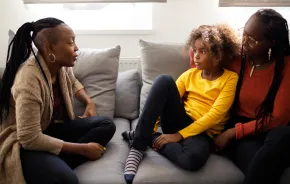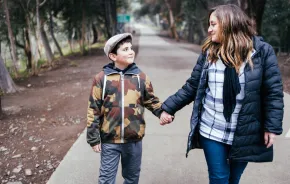
Editor’s note: This article was sponsored by Seattle Children’s Hospital.
In recent years, the U.S. has experienced a substantial shift in pediatric mental health awareness, slowly eroding the stigma that once cloaked these topics. From schools to parent support groups, more people are talking about children’s mental health needs.
“There’s more willingness to have discussions about how we connect with kids and how we intervene,” says Dr. Yolanda Evans, the Head of the division of adolescent medicine at Seattle Children’s Hospital.
A confluence of factors has led to the increased awareness and urgency of addressing youth mental health, from the tragedies of school shootings to the pandemic’s isolation, she said. These events coincided with a movement to address growing youth suicide rates, the second leading cause of death among 10 to 24 year-olds. Today, more people see youth mental health as less of a taboo topic, and more of a crucial and relevant matter that can impact anyone.
Even so, the stigma hasn’t completely disappeared. Despite the heightened focus in recent years, there’s still a sense that physical pain is more socially acceptable to discuss and share among adults and kids alike. For example, people might be more inclined to tell a friend about their chronic back pain than share ongoing struggles with depression. That’s partially a result of a culture that too often emphasizes a false sense of positivity, Evans said.
“In social media, people post when they’re happy and doing all the amazing things,” she says. “To share that we’re struggling emotionally is still not the norm.”
Removing the stigma
Stigma refers to the negative perceptions people might hold about someone who has a mental illness. These beliefs can lead to discrimination, isolation and worry.
Stigma can have powerful consequences, most notably keeping people from seeking mental health treatment, research has found. Youth who feel obliged to hide a condition often end up feeling worse and can turn to harmful actions such as substance use to help them cope. Creating more openness around mental health can help people find positive coping strategies.
With more than a fifth of U.S. children and youth experiencing behavioral health needs, accessing care before a crisis is critical, note researchers in the journal "Pediatrics." Steps such as screenings for mental health needs, as well as school-based interventions, can reduce the stigma and social isolation, and encourage parents to seek help for their children.
In recent years, there have been significant advances in bringing mental health issues to the forefront, removing the secrecy that can pervade these topics. Nationally, organizations like National Alliance on Mental Illness (NAMI) have used social media to share powerful personal stories that illustrate mental illness in real life.
In the Puget Sound area, schools are increasingly focusing on emotional intelligence, giving students the tools to talk about mental health in a way that makes sense. While younger children might remark on the color of moods, older students are increasingly adept at identifying the emotions that provoke strong responses. Evans has also noticed a growing movement away from labeling a kid as “bad” or “aggressive.”
How parents can combat stigma
Parents can play an important role in reducing mental health stigma for both their children and the people they encounter. Open dialogue paves the way for early interventions. Evans acknowledged that taking the time to stop what you’re doing and focus on mental health can be tough. But it’s well worth the effort.
“For anyone parenting, we are the most influential people in our kids’ lives,” Evans says. “Creating a space where kids feel safe to bring up things with us — that we’re not going to judge or blame — is really key to getting them help.”
For parents of younger kids, this might be as simple as naming emotions, narrating when a child is feeling upset or angry. Books such as “Pete the Cat” that discuss a character’s moods can help create fodder for important conversations about feelings and emotions.
“It’s really made an impact to share when you’re frustrated, sad or angry,” she says. “A child’s behavior may look the same for all of those, but naming helps you talk about it.”
If your child is struggling with a mental health challenge, it’s important to validate the impact and not minimize their experience. That means engaging in active listening without dismissing the feelings with comments such as “It will get better.” Instead, invite more discussion with phrases such as “Tell me more.”
Balancing openness with privacy
Removing stigma doesn’t mean you have to share the details of a mental health condition with everyone, though. A common question Evans often hears from her adolescent patients: Do I or do I not tell my friends?
Evans responds by empowering her patients, asking them if and what they want to share — while acknowledging that people will likely check in, especially if they are taking a break from a usual activity. Planning in advance for these questions is helpful.
“Friends do tend to notice and they’re going to ask,” she says. “That’s why it’s important for the teen and parents to be on board: Who are we going to loop in?”
Not everyone needs to know the same depth of information. For example, a teenager who is taking time off from a sport because of an eating disorder might share something like: “I have some things I need to take care of for my health.”
These questions also become vital for the parents themselves. Parents might want to discuss their child’s mental health struggles with fellow community members as part of their own processing and emotional support. That gets tricky, though, when the child isn’t on the same page. Sharing before a child is ready can erode trust. Since parents might have their own emotional needs surrounding a child’s mental health diagnosis, she’ll often counsel them to seek their own therapist.
“If we can’t talk to our best friend because the kids are close and information gets around, who can we share with in a safe space?” she said.
Despite the recent strides in addressing mental health stigma, misperceptions and judgments persist. That’s why it’s especially important for a family to have transparent, open and honest communication with each other.
“There’s still stigma around mental health,” she says. “As a family, we have to be aligned.”
Additional resources |
|
Sponsored by: |












